


FIM-92A Stinger Weapons System: RMP & Basic
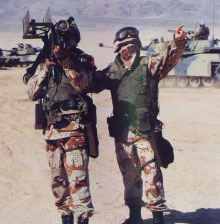
Developed by the United States Army Missile Command as a successor
to the Redeye Weapon System, the Stinger missile provides forward,
short-range air defense against low-altitude airborne targets. All
services have deployed the Stinger missile to protect combat forces,
forward bases, and/or high-value targets. The Stinger is launched
from a number of platforms: the shoulder-launched Man-portable Air
Defense System, Avenger (HMMWV), Bradley Linebacker, Light Amphibious
Vehicle - Air Defense (LAV-AD), Kiowa Warrior (OH-58D), and Special
Operations Black Hawks (MH-60). The Stinger is intended to fulfill
the Short-Range Air Defense (SHORAD) until 2018.
The Stinger system consists of a Stinger round encased in its
launch tube and a separate gripstock assembly.
The "fire-and-forget" Stinger missile employs a passive
infrared seeker to home in on its airborne target. A passive infrared
seeker emits no radiation that a target aircraft can detect, and,
instead, guides on the infrared energy (heat) emitted by the target.
Because the Stinger employs a passive homing seeker, it is a
"fire-and-forget" weapon that needs no guidance from the
operator after firing, unlike other missiles that track the reflection
of a designator beam, requiring the operator to maintain a lock on the
target. This allows a Stinger operator to take cover, relocate, or
engage other targets immediately after firing a Stinger.
The Stinger system features a proportional navigation system,
integrated Indentification Friend or Foe (IFF) interrogation, and
threat adaptive guidance. Proportional navigation enables the missile
to effectively hit moving targets by injecting a multiplier factor
into course corrections so that the missile overcorrects for a target's
evasive maneuvers, leading the target to a successful interception.
The integrated IFF subsystem allows the Stinger operator to query
a target aircraft to determine if it is friendly. Before firing, the
operator depresses a button on the gripstock assembly, emitting a
coded radio signal. Aircraft equipped with friendly IFF systems will
recognize the coded signal and respond with the appropriate coded
reply. The IFF subsystem emits one tone if it authenticates a
friendly aircraft, and another if the aircraft is unknown. The IFF
subsystem is intended to prevent friendly-fire incidents. The
Stinger's threat adaptive guidance takesover in the final stages of
its approach to the target, slightly shifting the missile's aim from
the target's IR hotspot to more vulnerable areas of the aircraft.
History
As early as 1946, the War Department Equipment Board concluded that
the existing .50 caliber machine gun did not have sufficient range or
velocity to be effective against targets of the future, particularly
low-flying aircraft. The Amry experimented with various antiaircraft
machine gun configurations, mounting various caliber machineguns on
radar-controlled carriages. In 1951, the Army Equipment Development
Board released requirements for a guided, surface-to-air missile,
leading to the development of the HAWK air defense system. HAWK did
not meet requirements for a lightweight, man-portable, low-altitude
air defense weapon, and private contractors developed prototypes for
such a weapon to demonstrate to the Army. The Army adopted a system
developed by Convair/Ponoma (later General Dynamics' Ponoma Division),
named Redeye for its single IR seeker.
During the 1960s, the military introduced the Redeye into Marine
Corps and Army units, providing those units with their first
lightweight, shoulder-fired surface-to-air missile. Certain units
began receiving Redeye missiles for training purposes in 1967; Redeye
achieved IOC in Oct. 1967. But by 1961, it was clear that the Redeye
system failed to fulfill at least three core capabilities. The Redeye
was not fast enough, could not maneuver soon enough, and could not
discriminate well enough to successfully engage its targets.
Advance development of the Redeye II began in 1967 as an outgrowth
of the Advanced Sensor Development Program which sought to the Redeye
with an all-ascpect engagement capability. Development of the Redeye
II, renamed as the XFIM-9A Stinger in March 1972, was awarded to
General Dynamics in June 1972. To reduce production costs, design
changes were implemented in 1975 to components from the missile and
place them in the receiver. The basic Stinger achieved IOC in
Feb. 1981. Stinger units replaced Redeye units on a one-for-one basis
throughout the next decade.
Variants
To date, the U.S. military has fielded four variants of the Stinger
missile system: the basic Stinger, Stinger POST, Stinger RMP, and Stinger
RMP Block I. In addition, the Army planned to field the Stinger RMP
Block II, but the Army divested itself of that program in the FY 2000
budget. The Army has also fielded an Air-to-Air Stinger (ATAS)
adapted for self-defense use by helicopters and light air units.
Product improvements to the Stinger have enhanced the missile's
capabilities by integrating advances in technology to cope with
advances in IR countermeasures and to provide the missile with new
capabilities.
The Stinger - Passive Optical Seeker Technique (POST) variant
replaces the original reticle-scan analog seeker with a dual IR and
ultraviolet (UV) detector employing rosette-pattern image scanning and
digital processing. The new seeker enhanced the missile's target
detection capabilities, allowing it to discriminate between a target,
countermeasures, and background clutter. Development of Stinger-POST
began in 1971, with production running from 1981 to 1987. By 1987,
when production of both the basic Stinger and Stinger-POST ended, more
than 15,000 basic Stinger and almost 600 Stinger-POST missiles
had been produced.
The Stinger-Reprogammable MicroProcessor (RMP) variant adds
additional microprocessor power and is highly countermeasures
resistant. External software reprogrammability allowed upgrades
without costly retrofit as the threat evolved. Upgrades to the
Stinger-RMP missile correct known operational deficiencies. Manpower
and readiness problems plagued the Army force modernization program in
the early 1980ís. It seemed that whenever a new system was put into
the hands of the soldier, actual field performance often failed to
match the standards predicted during its development. The Stinger
anti-aircraft missile, for example, was designed to hit incoming
aircraft better than 60 percent of the time. But if it had been placed
in service as originally designed, it would actually have achieved
hits only 30 percent of the time when operated by soldiers in combat
units. The Stingerís problems were eventually corrected. Operational
deficiencies were discovered during testing of the Stinger-RMP missile
in the late 1980s, and the Secretary of Defense directed the Army to
correct the deficiencies and then operationally test the fixes. The
proposed operational test, which consisted of 24 missile firings, was
approved by DOT&E via the TEMP in 1991. The Stinger-RMP missile test
program was suspended during Operation Desert Storm, and the missile
was rushed into the field in preparation for war. After the war, the
Army proposed a two-phased upgrade program, Stinger-RMP Block I and
Stinger-RMP Block II.
The Stinger-RMP Block I corrects deficiencies in the
Stinger-RMP missile to improve precision and performance. Software
and hardware changes incorporate a new Roll Frequency Sensor/Seeker, a
smaller battery, and an improved computer processor and memory. A ring
laser gyro eliminates the need to super elevate prior to firing while
other changes improve the accuracy and IRCCM capabilities of the
missile. Block I upgrades will "support the Army's Air and
Missile Defense strategy until 2021" (6).
Stinger-RMP Block II, cancelled in the Army's FY 2001
budget, proposed to improve both hardware and software, including an
advanced imaging focal plane array, roll frequency sensor, new
battery, signal processing, and advanced software. The Army
anticipated producing approximately 9,500 Stinger-RMP Block II
missiles.
The Air-to-Air Stinger [ATAS] is an adaption of the man
portable Stinger System. It is a light weight missile designed to
engage low altitude targets. A major milestone in the improvement of
the Air-to-Air Stinger (ATAS) Block-1 missile was demonstrated on 19
November 1996 at Yuma Proving Ground, AZ. An OH-58D piloted by CPT Bob
Blanchett, US Army Test and Evaluation Command (TECOM), successfully
acquired, tracked, engaged, and destroyed a QUH-1 drone helicopter
deploying countermeasures at a range greater than 4500 meters. This
firing also demonstrated the capabilities of the improved missile to
successfully engage a target without the requirement for super-
elevation.
All Air-to-Air Stinger (ATAS) Block II missiles will be
modified existing Stinger RMP missiles. The Block II retrofit program
will add the Block I modifications plus incoporate a starring IR focal
plane array seeker, a new battery, and advanced signal processing
capabilities. The new seeker will permit engagements of helicopters in
clutter out to the kinematic range of the missile. The missile and
launcher will be 1760 compatible. The Block II program will also
extend shelf, improve accuracy and IRCCM capabilities, and will
provide a full night capability.
The first Stinger Reprogrammable Micro Processor (RMP) missile was
successfully fired by a Kiowa Warrior while acquiring the target
through the seeker slaving mode at Yuma Proving Ground on 6 November
1997. This mode of acquiring the target dramatically simplifies the
procedure and should decrease the acquisition/engagement time lines in
most instances. Essentially, the system slews the Stinger missile's
seeker to an off-axis position coincident with the Mast Mounted
Sight's (MMS) line of sight (LOS). Considering the missile seeker's
relatively small field of view, the capability to accurately direct
the seeker onto a target being tracked by the MMS is a significant
advantage. In practicality, the pilot no longer has to meticulously
fly the missile to the target by aligning the center cross with the
MMS LOS cue. He merely flies the aircraft to the "ballpark" of the MMS
LOS and initiates first detent, allowing the seeker to slew to the
target, uncage and begin tracking it. This capability will afford the
greatest advantage while acquiring from a hover position in unstable
wind conditions with the RMP missile. Seeker slaving is enabled by the
Improved Master Controller Processor Unit (IMCPU) which is included
with the digitized Kiowa Warriors. Non-digitized Kiowa Warriors may be
equipped with seeker slaving by adding a card in the Integrated System
Processor. Eventually, all Kiowa Warriors will gain seeker slaving as
they are converted to the digital configuration.
Specifications
|
| Primary function | To provide close-in, surface-to-air weapons for the defense of forward combat areas, vital areas and installations against low altitude air attacks.
|
| Manufacturer | Prime - Hughes Missile System Company
Missile - General Dynamics /Raytheon Corporation
|
| Propulsion | Dual thrust solid fuel rocket motor
|
| Length | 5 feet (1.5 meters)
|
| Width | 5.5 inches (13.96 centimeters)
|
| Weight | 12.5 pounds (5.68 kilograms)
|
| Weight fully armed | 34.5 pounds (15.66 kg)
|
| Maximum system span | 3.6 inches (9.14 cm)
|
| Range | 1 to 8 kilometers
|
| Sight ring | 10 mils
|
| Fuzing | Penetration, impact, self destruct
|
| Ceiling | 10,000 feet (3.046 kilometers)
|
| Speed | Supersonic in flight
|
| USMC Units | Low-Altitude Air Defense (LAAD) Battalions: 3 active duty, 2 reserve
|
| Crew | 2 enlisted
|
| Guidance system | Fire-and-forget passive infrared seeker
|
| Warheads | High explosive
|
| Rate of fire | 1 missile every 3 to 7 seconds
|
| Type of fire | "Fire-and-Forget"
|
| Sensors | Passive infrared
|
| Introduction date | 1987
|
| Full-rate production | 3QFY94
|
| Unit Replacement Cost | $38,000
|
| Total program cost (TY$) | 1060 systems $7281M
|
| Average unit cost (TY$) | $6M
|
| Inventory | ~13,400 missiles
|
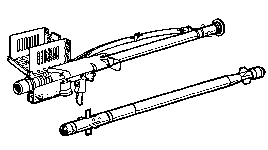
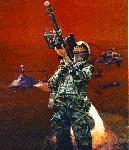
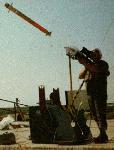
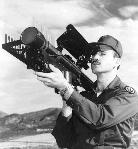
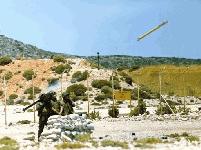
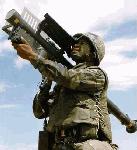



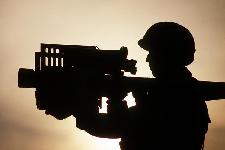


For information efforts to control the proliferation of the Stinger and other MANPADS, see
ASMP Issue Brief #1: MANPADS Proliferation
Sources and Resources
- AVENGER - LAAD TEAM ORGANIC VEHICLE
- Light Armored Vehicle (Air Defense Variant)
- Stringer Weapon System: RMP & Basic, United States Marine Corps FactFile.
- Stinger, Raytheon (primary contractor) product information.
- Stinger, US Army Weapon System Handbook 2002.
- Missile Procurement, Army, FY 2003 Budget Submission
- Stinger Weapon System [Chapter 2 - MCWP 3-25.10]
- STINGER / AVENGER - System chronology @ Redstone
http://www.fas.org/man/dod-101/sys/land/stinger.htm
Maintained by Robert Sherman
Originally created by John Pike
Updated Wednesday, August 09, 2000 1:10:40 PM















